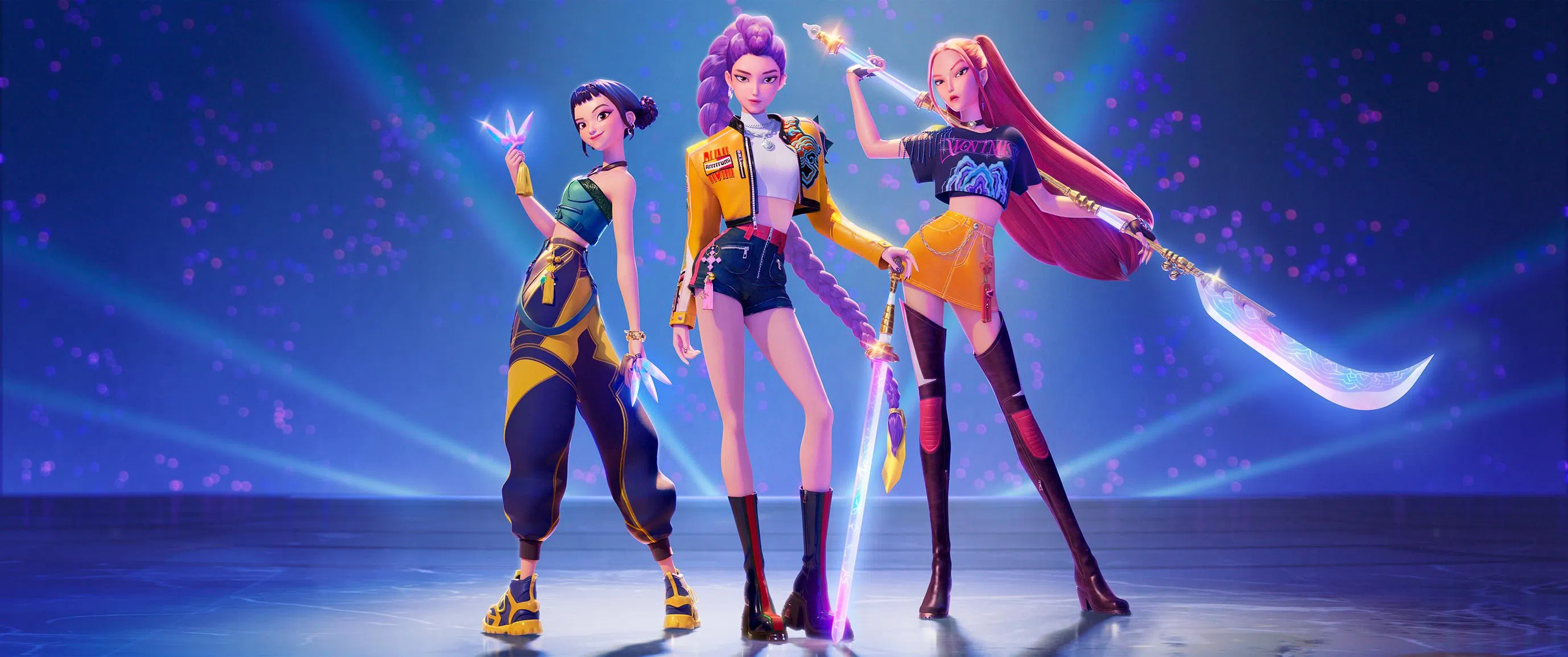KPop Demon Hunters took 7 years to make but a lifetime of experience, says creator
Sign up now: Get ST's newsletters delivered to your inbox

Animation film KPop Demon Hunters has inspired countless memes and dance challenges.
PHOTO: NETFLIX
Regina Kim
Follow topic:
NEW YORK – Since its release on Netflix in June, the original animated film KPop Demon Hunters has burned up the internet – and the charts.
The musical fantasy has topped the streamer’s global rankings and inspired countless memes, dance challenges, themed merchandise and fan art. The movie’s equally blockbuster soundtrack has stormed the music charts, with eight of its songs landing on the Billboard Hot 100.
KPop Demon Hunters follows the members of Huntrix, a fictional K-pop girl group, as they juggle demanding careers and fight to save the world from soul-stealing demons.
The film’s directors and co-writers Maggie Kang – a Korean-Canadian veteran storyboard artist on films including Rise Of The Guardians (2012) and Puss In Boots (2011) – and American illustrator Chris Appelhans (who directed 2021’s Wish Dragon) spoke about the making of their movie and its unexpected rise as a global cultural phenomenon.
Here are edited excerpts from the conversation.
Maggie, the story behind KPop Demon Hunters was your idea. What convinced you that a film which combines disparate elements like K-pop, animation, traditional Korean art and mythology, and demons could resonate with so many audiences?
Maggie Kang: Well, nothing did. I was just trying to make something I wanted to see: A movie that celebrated Korean culture. And for some reason, I landed on demonology.
The jeoseung saja (grim reapers in Korean mythology) – which is what the members of boy band Saja Boys are at the end of the movie with the black hats and the black robes – was such an iconic image from my childhood that I was very scared of, so I knew I wanted to feature that.
And the thought of demons naturally led to demon hunters. I wanted to see female superheroes that were a lot more relatable, who like to eat and make silly faces. We were not trying to make them just pretty, sexy and cool. They had insecurities and showed that.
Demon hunting is usually done very secretly, so these girls needed a public-facing persona. I also wanted to do something K-pop-related. It was like, let’s just see if these two things can go together.
How did you two end up working together on this project?
Chris Appelhans: Aron Warner, the producer who did Wish Dragon, was helping Maggie develop this. He said: “You should meet Maggie. She’s really smart, and this idea is really cool.” He was right.
Maggie told me about it, and about 10 minutes in, I was trying to play it cool, but on the inside, I was like: “Please let me work on this movie with you.”
When you’re trying to make movies, you’re looking for something moving that you have not seen before, and they just do not come along very often. This was one of those things.
We essentially never disagreed. We had different strengths, but also, I think the sum of our brainpower made for a nice mix.
When I first heard the title and read the premise, I was sceptical. How did you pitch your idea to Sony Pictures Animation?
Kang: K-content is very popular, and it was at the height of boy band BTS’ popularity that this was pitched, so I don’t think it was a hard sell. If you were not living under a rock, you knew how big BTS and K-content were.
It was almost seven years to the day, from pitching it to the release. I had known Aron for a long time as well. When he landed at Sony with Wish Dragon, he called me and said, “Do you have anything that you want to pitch me?”
I pitched it like, “It’s a K-pop girl group, and they hunt demons secretly.” And he’s like, “I love it.” I thought he was joking. But the next week, he had a deal ready.
A few months into development, Sony Pictures Animation president Kristine Belson was like, “I think this has big movie potential.” So, we started to look for a directing partner, and that’s when Chris came on.
Korean-American singer-songwriter Ejae, who does the vocals for (female lead) Rumi, was on super early and wrote a couple of demos for the first song, How It’s Done, and a version of the duet Free. We played those two as proof of concept for music.

Eight of animation film KPop Demon Hunters' songs have landed on the Billboard Hot 100.
PHOTO: NETFLIX
Did you have a particular audience in mind? There are many people who are not K-pop fans who are enjoying this movie.
Kang: When I was a teenager and loved K-pop, I spent all my money on that. I went to an all-girls school, and when Titanic (1997) came out, I had friends who watched it in the theatres like seven, eight times.
I was like, why isn’t anybody tapping this obsessive, teenage girl love? So, I was trying to make a movie for my current self, of course, but also for my teenage self. Recently, somebody said, “It seems like you made a movie for teenage girls, but maybe there’s a teenage girl in everybody.”
Romance, friendship and the idea of shame and hiding yourself – I think there are a lot of themes and ideas that are speaking to a global audience because they’re something that everybody relates to. That is also the reason I wanted to make the movie as Korean as possible, because I wanted to prove it does not matter what culture something is set in. It’s all about the characters and the story. NYTIMES
KPop Demon Hunters is available on Netflix.

